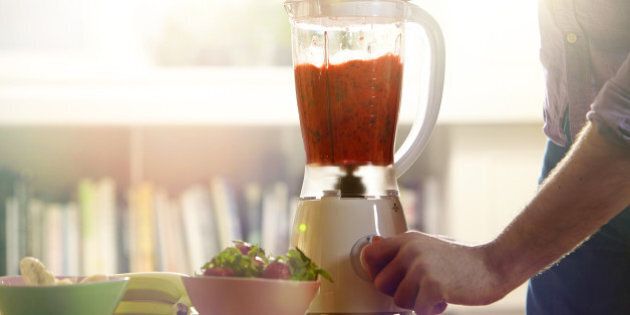

Image courtesy of Vladislav Nosick
It depends on which smoothie/juice junkie you ask. One thing is for sure; the marketing for popular blender brands surpasses that of any juicer.
When was the last time you heard someone talk about their juicer?
According to Gadget Review, the top three blender brands of 2016 are no surprise:
What is a blender?
Obvious answer: A blender is for blending.
A blender blends a lot more than just smoothies. Here's a list of 20 foods that only a high powered blender can make:
- 1) Pancake batter
- 2) Pesto
- 3) Lassi (popular yogurt based drink to cool you down on those hot summer days)
- 4) Ice creams and sorbets
- 5) Hummus
- 6) Chutneys
- 7) Soups
- 8) Tapenade
- 9) Guacamole
- 10) Pudding
- 11) Lattes
- 12) Nut butters
- 13) Salad dressings
- 14) Butter cream icings
- 15) Margaritas and other cocktails
- 16) Mash potatoes
- 17) Fruit jams
- 18) Whip cream
- 19) Flavoured butters
- 20) Whipped cheeses: ricotta, feta and cream cheese
High performing blenders are popular for health nuts, lazy people, busy people and just everyday people for a number of reasons; 1) They're powerful 2) They're easy to clean (simply mix soap and water and blend for 60 seconds or less), and 3) They're easy to use for a variety of things beyond smoothies.
However, high-powered blenders also come with a hefty price tag, ranging from $150-550, (surprisingly, they don't cost much more than a good quality juicer, which runs anywhere from $150-400.)
There are valid reasons as to why these gadgets are priced so high, besides the ones mentioned above. Two main reasons that seperate a high end blender from a low end one are 1) They last longer and 2) Taste. For example, you're able to get a smooth tasting celery soup, night after night, without having any raw, stringy fibers getting stuck between your teeth, ruining the texture and your taste buds.
Not all blenders can handle pureeing hard, fibrous, wiry veggies like celery, kale and carrots into a rich, silky texture, like the mighty Blendtec, Vitamix and Oster Versa can.
Gone are the days of the stop and start blending method. Remember, back in the day, you would stop the blender, push the food down or around before restarting it. Nowadays, Ain't Nobody Got Time for That!
If you're looking to invest in a blender, you should ask yourself, what will I be using it for? Once you have that question answered, assess the following qualities in your new blender-to-be:
- How many speeds does it have?
- How many preset programs does it come with?
- What is the size of the container?
- How powerful is it? Can it turn hard, muscular, pulpy foods into baby mush?
- Is it built for everyday use?
- How long is the warranty? Six year minimum is ideal
Then there's the robust juicer.
What is a juicer?
Obvious answer: A juicer is only for making juices.
Juicers have more variety when it comes to the extraction methods; two common types are the masticating modeland the centrifugal model.
Centrifugal juicers are the more popular choice. The metal blades spin at a rapid speed separating the juice from flesh of the fruit. This tends to cause more heat and oxidation. Yet, what people may not know is that the heat doesn't make the juice any less nutritious, unless the heat exceeds 118 degrees.
Oxidation occurs with all juicers, the way to minmize it is by drinking your juice right after it's made.
Keep in mind, centrifugal juicers can't juice leafy greens.
The masticating juicer is a cold press juicer. You feed the food into the top tube where the food gets crushed and pressed at a much slower speed than the centrifugal method. This process minimizes the heat (hence why it's known as the cold press method.) Plus, this way no nutrition is lost, because there's no heat involved.
Can you use a blender for juicing?
Blenders aren't made for juicing. If you try, it will turn your drink into a smoothie, not a juice.
Simple rule: blending keeps fibers in the liquid, while juicing separates them.
Both juicers and blenders give you a proper, dense dose of nutrition that your body will perk up from. They're just different.
Ask yourself, do you want your latest kitchen gadget to make snacks, dips, meals and smoothies or a just a really good, concentrated, healthy juice? Your choice.
Follow HuffPost Canada Blogs on Facebook